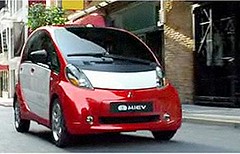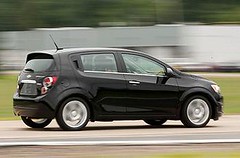 美國環保署與運輸部在16日正式推出了他們的聯合提案,為2017至2025年間的轎車與輕型卡車設置更高的燃油效率以及溫室氣體排放標準。
美國環保署與運輸部在16日正式推出了他們的聯合提案,為2017至2025年間的轎車與輕型卡車設置更高的燃油效率以及溫室氣體排放標準。
這項平均燃油效率標準(Corporate Average Fuel Economy, CAFE)要求,2021年生產的車型必須達到每加侖行駛40.1英里,2025年生產的車型則要達到每加侖49.6英里的水準,這個數字是所有轎車與卡車相加後的平均值。
環保署所建議的溫室氣體標準與CAFE的標準是一致的,都要求2025年的車型每行駛1英里二氧化碳排放量低於163公克。環保署表示,如果僅通過提高燃油效率來達成目標的話,此二氧化碳排放標準相當於每加侖54.5英里。
轎車、運動休旅車、箱型車以及貨卡等四類車種,占了美國所消耗的能源相關石油與溫室氣體排放量的60%。
這些機構表示,所訂定的標準將使那些年內出售的汽車,在其壽命中減少消耗石油量達40億桶,溫室氣體排放減少20億噸。
汽車製造商聯盟總裁兼執行長Mitch Bainwol說,「這項提案延續建立了一個單一且國家級的燃油經濟與溫室氣體排放方案,整體來說是走在正確的方向上。」
「所提的計畫目標看來很有企圖心,」Bainwol 說,「有關當局要考慮到這需要科技的突破以及消費者大量的購買高效節能車才能達成目標。」
美國環保署長Lisa Jackson說,「透過設置長期穩定提升燃油經濟效益的過程,歐巴馬政府確保美國的購車者能夠選擇採購美國史上最有效能的車輛。這樣能夠讓購車者省錢、減少美國石油消費並減少排放有害物質到我們所呼吸的空氣中。」
 由於汽車製造商已投入數十億美金研發新科技,讓現在的消費者在採購節能車時有很多選擇,Bainwol 說道。
由於汽車製造商已投入數十億美金研發新科技,讓現在的消費者在採購節能車時有很多選擇,Bainwol 說道。
在16日公布的這項法案,是基於歐巴馬政府早期針對2012至2016年間車型,所成功推動的國家方案。該CAFE方案的標準將燃油效率在2016年遷提升至相當於每加侖行駛35.5英里,並使輕型車每英里的平均二氧化碳排放量在250公克內。
結合原來的2012至2016年以及新的燃油經濟效率標準後,美國環保署表示,「新的提案宣示了有史以來聯邦政府在減少溫室氣體排放以及提升燃油效率上,最顯著的行動。」
總體而言,這些法案將減少一半的溫室氣體排放,而且使2025年的輕型車的燃油效率將近是2010年的兩倍。
汽車製造商說,新的CAFE標準將創造更多就業機會。
 「多數小型企業組織(Small Business Majority)」創辦人兼執行長John Arensmeyer表示,其多數會員都支持CAFE標準。
「多數小型企業組織(Small Business Majority)」創辦人兼執行長John Arensmeyer表示,其多數會員都支持CAFE標準。
「根據我們來自全美超過1200名小企業主的調查顯示,87%的小型企業壓倒性的支持採用新標準,80%的小型企業支持汽車界將2025年的標準提高到每加侖60英里的水準-這是一個比歐巴馬政府所提更高的標準。」
Arensmeyer 說,「小企業主認為更嚴格的燃料里程標準能幫助美國汽車製造商不斷創新、提升效率並在全球經濟中有競爭力。」
The U.S. Environmental Protection Agency and the U.S. Department of Transportation today formally unveiled their joint proposal to set stronger fuel economy and greenhouse gas emissions standards for model year 2017-2025 passenger cars and light trucks.
The proposed Corporate Average Fuel Economy, or CAFE, standards are projected to require 40.1 miles per gallon in model year 2021, and 49.6 mpg in model year 2025, on an average industry fleet-wide basis for cars and trucks combined.
The EPA's proposed greenhouse gas standards, which are harmonized with the CAFE standards, are projected to require emissions of no more than 163 grams/mile of carbon dioxide, CO2, in model year 2025. This CO2 standard is equivalent to 54.5 mpg if this level of emissions were achieved solely through improvements in fuel efficiency, the EPA says.
The 2012 Mitsubishi i-MiEV electric car is the fuel economy leader according to the latest EPA figures, released November 16, 2011 (Photo courtesy Mitsubishi)
Cars, SUVs, minivans, and pickup trucks are currently responsible for nearly 60 percent of U.S. transportation-related petroleum use and greenhouse gas emissions.
These proposed standards will cut oil consumption by four billion barrels and cut two billion metric tons of greenhouse gas emissions over the lifetimes of the vehicles sold in those years, the agencies said.
Mitch Bainwol, president and CEO of the Alliance of Automobile Manufacturers, said, "This proposal continues the approach of establishing a single, national fuel economy program for fuel economy and greenhouse gas emissions, which is the right overall direction."
"The proposed regulations present aggressive targets," Bainwol said, "and the administration must consider that technology breakthroughs will be required and consumers will need to buy our most energy-efficient technologies in very large numbers to meet the goals."
The fuel-efficient 2012 Chevrolet Sonic gets 40 mpg on the highway and achieves zero-to-60 mph in 8.2 seconds. (Photo courtesy Chevrolet)
EPA Administrator Lisa Jackson said, "By setting a course for steady improvements in fuel economy over the long term, the Obama administration is ensuring that American car buyers have their choice of the most efficient vehicles ever produced in our country. That will save them money, reduce our nation's oil consumption and cut harmful emissions in the air we breathe."
Consumers now have many choices when shopping for fuel-efficient vehicles because automakers have invested billions of dollars in new technologies already, said Bainwol.
Today's action builds on the success of the first phase of the Obama administration's national program, which covers the model years 2012-2016. These earlier CAFE standards raise fuel efficiency equivalent to 35.5 mpg by 2016 and result in an average light vehicle tailpipe CO2 level of 250 grams per mile.
Combined with 2011 fuel economy standards and the standards in effect for 2012-2016, "Today's proposal represents the most significant federal action ever taken to reduce greenhouse gas emissions and improve fuel economy," the EPA says.
In total, these actions would reduce greenhouse gas emissions by half and result in model year 2025 light-duty vehicles with nearly double the fuel economy of model year 2010 vehicles.
2012 Ford Focus assembly line worker Elainna Sammons at the Michigan Assembly Plant (Photo by Sam VarnHagen courtesy Ford)
Automakers say the newly proposed CAFE standards will create more jobs.
Small Business Majority founder and chief executive John Arensmeyer said his members are behind the new CAFE standards.
"Our poll of more than 1,200 small business owners across the country found 87 percent of small business owners overwhelmingly support adopting strong standards now, and 80 percent support requiring the auto industry to increase mileage to 60 mpg by 2025 - an even stronger standard than the one the Obama Administration has announced."
Arensmeyer said, "Small business owners say stronger gas mileage standards will help American automakers innovate, improve efficiency and compete in the global economy."







